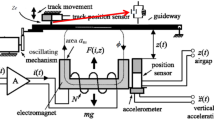Abstract
This paper describes a sliding-mode observer design for state estimation of a motorized seat belt (MSB) system. The MSB system is an active safety system that can protect passengers and improve passenger convenience by several operations, which prevent and warn to passengers about dangerous driving conditions and reduce the dangerous situation caused by slack and poor return of seat belt. To realize these operations, state information such as the belt winding velocity and tension of belt are required. However measuring this information with sensors increases the system cost and complexity. In this paper, a sliding-mode observer, which estimates requisite state information, is proposed. The designed sliding-mode observer is robust towards system uncertainties and parameter variation and is verified in matched and mismatched parameter cases.
Similar content being viewed by others
References
He, B., Ouyang, M. and Lu, L. (2006). Modeling and PI control of diesel APU for series hybrid electric vehicles. Int. J. Automotive Technology 7, 1, 91–100.
Husain, I., Veillette, R. J. and Batur, C. (2003). Design and performance analysis of sliding-mode observers for sensorless operation of switched reluctance motors. IEEE Trans. Control Systems Technology 11, 3, 383–389.
Jin, H., Choi, S. and Kim, S. (2014), Design of a compressor-power-based exhaust manifold pressure estimator for diesel engine air management. Int. J. Automotive Technology 15, 2, 191–201.
Jin, S. and Lee, W. (2007). A study on the experimental parameter identification for electronic throttle body. KSAE Spring Conf., 4, 2245–2250.
Jung, Y. and Kim, M. (2009). Sliding mode observer for sensorless control of IPMSM drives. J. Power Electronics 9, 1, 117–123.
Kim, H., Heo, S. and Kang, G. (2008). Modeling and state observer design of HEV Li-ion battery. J. Power Electronics 13, 5, 360–368.
Kim, S., Kim, I., Jeong, G., Ju, S., Kim, M. and Son, Y. (2009). Experiments for current estimation of a DC/DC boost converter using luenberger observer. KIEE Information and Control Symp., 385–386.
Lee, J. H., Lee, H. J. and Sunwoo, M. (2014). Nonlinear sliding mode observer for exhaust manifold pressure estimation in a light-duty diesel engine. Int. J. Automotive Technology 15, 3, 377–386.
Lee, K., Choi, C. and Lee, W. (2013). Retraction control of motorized seat belt system with linear state observer. J. Central South University 20, 2, 385–392.
Lee, K., Choi, C. and Lee, W. (2012). A design of linear state observer for motorized seat belt system. Trans. KSAE 20, 3, 1–147.
Li, Z., Chen, J., Gan, M., Fang, H. and Zhang, G. (2010), Adaptive robust dynamic surface control of DC torque motors with true parameter estimates. American Control Conf., 3524–3529.
Luenberger, D. (1971). An introduction to observers. IEEE Trans. Automatic Control, AC-16, 596–602.
Mallon, N., Wouw, N., Putra, D. and Nijmeijer, H. (2006). Friction compensation in a controlled one-link robot using a reduced-order observer. IEEE Trans. Control systems Technology 14, 2, 374–383.
Matsuo, T. and Lipo, T. A. (1985). A rotor parameter identification scheme for vector-controlled induction motor drives. IEEE Trans. Industry Applications IA-21, 3, 624–632.
Metni, N., Pflimlin, J., Hamel, T. and Soueres, P. (2006). Attitude and gyro bias estimation for a VTOL UAV. Control Engineering Practice 14, 12, 1511–1520.
Min, S., Lee, J. and Kim, B. (2004). Development of precresh safety system using motorized seat belt. KSAE Spring Conf., 4, 1219–1224.
Mohan, N. (2001). Electric Drives: An Integrative Approach. Mnpere. Minneapolis.
M’sirdi, N. K., Rabhi, A., Fridman, L., Davila, J. and Delanne, Y. (2006). Second order sliding mode observer for estimation of velocities, wheel sleep, radius and stiffness. American Control Conf. DOI: 10.1109/ACC.2006.1657230.
Nollet, F., Floquet, T. and Perruquetti, W. (2008). Observerbased second order sliding mode control laws for stepper motors. Control Engineering Practice 16, 4, 429–443.
Pal, T., Shekhar, C. and Sharma, H. D. (2009). Design and development of embedded system on ARM for on-line characterization of DC motor. Advances in Computing, Control & Telecommunication Technologies Int. Conf., 502–506.
Park, J., Tak, T., Kim, I., Kuk, M., Kim, D., Sin, S., Kim, J., Lee, D. and Kim, S. (2006). Driving mechanism design of a motorized seatbelt retractor. KSME Conf., 2951–2956.
Ren, Z., Gerland, P. and Kroll, A. (2011). A novel frictionidentification method using sliding-mode observer and its application to electro-mechanical Throttles. 18th IFAC World Cong., 18, 4803–4808.
Roberts, J. (1978). Use of the butterworth low-pass filter for oceanographic data. J. Geophysical Research 83, C11, 5510–5514.
Sarptuk, S. (1987). On the stability of discrete-time sliding mode control systems. IEEE Trans. Automatic Control 32, 10, 930–932.
Tokoro, S., Moriizumi, K., Kawasaki, T., Nagao, T., Abe, K. and Fujita, K. (2004). Sensor fusion system for precrash safety system. IEEE Intelligent Vehicles Symp., 945–950.
Utkin, V. (1993). Sliding mode control design principles and applications to electric drives. IEEE Trans. Industrial Electronics 40, 1, 23–36.
Utkin, V. (1977). Variable structure systems with sliding modes. IEEE Trans. Automatic Control 22, 2, 212–222.
Wu, J., Tang, H., Li, S. and Zheng, S. (2007). Integrated control system design of active front wheel steering and four wheel torque to improve vehicle handling and stability. Int. J. Automotive Technology 8, 3, 299–308.
Zhang, Y., Zhang, J., Shangguan, W. and Feng, Q. (2007). Modeling and parameter identification for a passive hydraulic mount. Int. J. Automotive Technology 8, 2, 233–241.
Zhu, L. (2004). Real-time multiple parameter estimation for voltage controlled brushless DC motor actuators. American Control Conf., 3851–3856.
Author information
Authors and Affiliations
Corresponding author
Rights and permissions
About this article
Cite this article
Lee, K.S., Lee, W.T. State estimation for motorized seat belt system using sliding-mode observer. Int.J Automot. Technol. 16, 301–308 (2015). https://doi.org/10.1007/s12239-015-0032-3
Received:
Revised:
Accepted:
Published:
Issue Date:
DOI: https://doi.org/10.1007/s12239-015-0032-3




